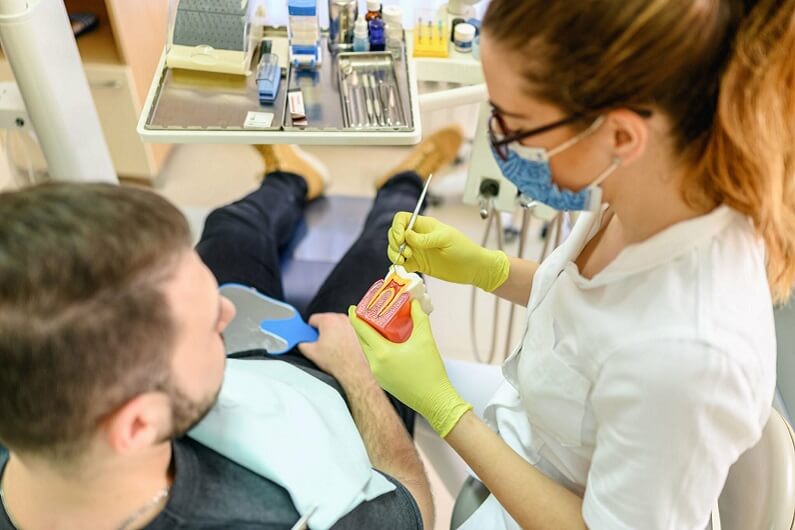Gum disease, also known as periodontal disease, is a common dental problem that can affect anyone. If you’re reading this, chances are you or someone you care about is concerned about gum disease and wants to know how to deal with it. You’re not alone in this journey, and it’s essential to take proactive steps to maintain healthy gums and prevent gum disease from progressing.
In this comprehensive guide, you will learn everything you need to know about treating gum disease. From understanding the causes and symptoms to exploring various treatment options and preventive measures, everything you need to know is right here.
Understanding Gum Disease: Causes and Symptoms
Before diving into the topic of treatment options, it’s crucial to understand what gum disease is, what causes it, and how to identify its symptoms.
What is Gum Disease?
Gum disease, or periodontal disease, is an inflammatory condition that affects the tissues supporting your teeth. It starts with the accumulation of plaque, a sticky film of bacteria, on your teeth and gums. Over time, if left untreated, it can progress and lead to more severe problems, including tooth loss.
What Causes Gum Disease?
The primary cause of gum disease is the buildup of plaque on your teeth. Other factors that contribute to its development include:
- Poor dental hygiene
- Excessive tobacco use
- A poor diet
- Genetics
- Other medical conditions
What Are The Symptoms Of Gum Disease?
Recognizing the early signs of gum disease is essential for prompt treatment. Common symptoms include:
- Bleeding gums
- Red or swollen gums
- Bad breath
- Receding gums
- Any pain or discomfort
Treatment Options For Gum Disease
Now that you have a better understanding of what gum disease is and how to identify it, you can explore the various treatment options available to combat this condition. The choice of treatment will depend on the severity of your gum disease.
Scaling And Root Planing
Scaling and root planing, often referred to as deep cleaning, is a non-surgical procedure performed by a dentist or dental hygienist. It involves removing plaque and tartar (hardened plaque) from the surfaces of your teeth and their roots. The roots are then smoothed to prevent further plaque buildup. This treatment is typically recommended for early-stage gum disease, known as gingivitis.
Prescribed Medications
In some cases, your dentist may prescribe medications to help manage gum disease such as antibiotics, antiseptic mouthwash, or enzyme suppressants which can inhibit the enzymes responsible for breaking down your gum tissue.
Oral Surgery
For more advanced cases of gum disease, surgical procedures may be necessary. Flap surgery, bone grafting, and soft tissue grafting are among the most common surgeries for treating gum disease.
Laser Therapy
Laser therapy is a relatively new approach to treating gum disease. It involves using a laser to remove infected tissue and promote the regeneration of healthy gum tissue. Laser therapy can be less invasive than traditional surgery and may result in less discomfort and faster healing.
Ongoing Care
Regardless of the treatment method used, it’s essential to follow up with ongoing maintenance to prevent gum disease from recurring. This typically includes regular dental check-ups and cleanings, as well as diligent oral hygiene practices at home.
Preventing Gum Disease
The old adage that “prevention is better than cure” holds true for gum disease. While treatments are available, it’s far easier and less expensive to prevent gum disease from developing in the first place. Here are some practical steps you can take to keep your gums healthy:
1. Practice Good Oral Hygiene
The foundation of gum disease prevention is maintaining proper oral hygiene:
- Brush: Brush your teeth at least twice a day with fluoride toothpaste.
- Floss: Floss daily to remove food particles and plaque from between your teeth and along the gumline.
- Use Mouthwash: An antimicrobial mouthwash can help kill bacteria in your mouth.
2. Quit Smoking
Tobacco use is a significant risk factor for gum disease. Quitting smoking or using tobacco products can greatly reduce your risk.
3. Eat A Balanced Diet
A diet rich in fruits, vegetables, lean proteins, and whole grains can support gum health. Avoid excessive consumption of sugary and processed foods.
4. Stay Hydrated
Drinking water helps maintain a healthy mouth by rinsing away food particles and bacteria.
5. Manage Stress
Stress can weaken your immune system, making it harder for your body to fight off gum infections. Practice stress-reduction techniques like meditation or yoga.
6. Regular Dental Checkups
Visit your dentist for regular check-ups and cleanings. They can detect early signs of gum disease and provide guidance on maintaining good oral health.
7. Know Your Risk
If you have a family history of gum disease or medical conditions like diabetes, be vigilant about your oral health and discuss your risk with your dentist.
8. Avoid Teeth Grinding
Bruxism, or teeth grinding, can contribute to gum problems. If you grind your teeth at night, consider using a mouthguard.
The Main Takeaways
Gum disease is a prevalent condition, but it’s also highly preventable and treatable. With the right knowledge and proactive steps, you can maintain healthy gums and a beautiful smile. Remember to practice good oral hygiene, seek professional dental care, and make healthy lifestyle choices. If you suspect you may have gum disease, don’t hesitate to reach out to your dentist for an evaluation and personalized treatment plan. Your gums will thank you, and your smile will shine brighter than ever.
Manage Gum Disease At Southridge Dental Group!
Ready to take the first step towards healthier gums and a brighter smile? Contact Southridge Dental Group today and schedule your dental check-up with our experienced team. Don’t wait – your oral health is our priority, and we’re here to help you achieve the smile you deserve. Call us now at 909-822-9090 to book your appointment!

